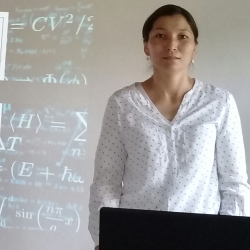Просмотр содержимого документа
«Биология 9-класс Англис тилинде»

Topic 32: Transport of O 2 and CO 2
O 2 requirement is 300 L in a day. Blood has high O 2 carrying capacity which is 6 times greater than that of water.
Hemoglobin: There are normally 280 million hemoglobin molecules in each human erythrocyte. A hemoglobin molecule can bind 4 O 2 molecules.
O 2 transport
- only 3% of O 2 carried by blood plasma
- 97% of O 2 is transported by RBC (hemoglobin)
(Oxyhemoglobin)
CO 2 transport
- 7% of CO 2 dissolves in plasma
- 20% of CO 2 is carried by RBC to form carboxyhemoglobin
- 73% of CO 2 is transported as bicarbonate ions (HCO 3 - )

Topic 33: Mechanism of Breathing
Lungs: are the main respiratory organ located in the thoracic cavity. Pleural membrane covers and protects the lungs by lubricating. Has 3 lobes at right lung and 2 lobes at left lung.
Breathing is controlled by medulla oblongata and muscles like diaphragm and rib muscles .
Inhalation (inspiration) vs Exhalation (expiration)

Inhalation :
Exhalation:
Chest cavity expands
Chest cavity reduces
Ribs muscles contracts
Rib muscles relax
Diaphragm flattens (contracts)
Diaphragm move upward (relax)
Pressure in the lung decreases
Pressure in the lung increases
Breathing rate is 16 times per minute at rest. Some factors affect breathing rate such as:
1) exercise
2) heart and respiratory diseases
3) low level of oxygen, thus high level of CO 2 in the blood (blood's pH; acidity)

Topic 34: Digestive System
- The process of breaking down food into molecules the body can use is called digestion .
- Foods are: sugars, proteins, lipids (fats, oil)
-
- Main steps:
- 1. Ingestion : to take in food (eating, drinking)
- 2. Mechanical digestion : breaking down food mechanically by the help of teeth. Mechanical digestion not only happens in the mouth but also in the stomach and in small intestine .
- 3. Chemical digestion : when the food is broken down to small pieces, it is digested by the help of special chemical substances called enzymes until the food becomes its smallest molecules (glucoses, amino acids, fatty acids).
- 4. Absorption : if the food is chemically digested and converted to glucoses, amino acids, and fatty acids, it is absorbed by the blood or lacteal (lymphatic vessels). They are carried as a food to body cells. This happens in small intestine.
- 5. Defecation : if the food is not digested, it cannot be absorbed by blood. It stays in the digestive tract and removed later from the body.
-
- All the way, food is transported in the digestive tract by the help of smooth muscle contractions called peristalsis .

Write the all of topics,draw the pictures.See the video this link https://www.youtube.com/watch?v=_ QYwscALNng . https:// www.youtube.com/watch?v=URrXh0LJ6JE. Activity book until digestive system.Home work






















